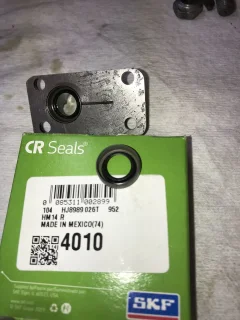- Joined
- Mar 12, 2019
- Messages
- 48
So as u can see on the plot, the lapping helped the old pump considerably,
adding on average close to 40% more flow at pump rpms near 400 corresponding to about 900 engine rpm. But the surprise was how more rpm hardly made any difference. My drill only went up to 1360 rpm, close to 3000 emgine rpm. But the flow didnt increase much. Two things; at the higher rpm the oil from the pump was raelly aerated, really foamey. Also during the higher speed runs only, all together about 2 1/2 teaspoons leaked from between the drive shaft and its bore. At this point i suspect this shaft to bore clearance is allowing too much air to enter and oil to leak out. For my test setup that more less mimics the engine installation, i calculate a couple psi of pressure at idle rpm. U have the foot of pressure head, 2.5” of 3/16” dia passage, and 24” of 0.25” dia hose to pass thru to the upper collector that represens the bikes tank. The governing formula for the two
passage restrictions to flow is: pressure = [8 x lenght of passage x viscosity x flow rate ] divided by [3.14 x passage radius to fourth power]
I did it the hard way and then finally found an online calculator to double check and they agreed well. If anybody is interested i can give a sample calc with all the proper units, etc in another post. Bottom line it looks like my pump has a low threshold where a little pressure developed by higher than idle rpm flows causes it to leak oil and suck air excessively. I need to take a more detailed look at the shaft to bore fit. Enuf for now but stay tuned. Hope i havent raised more questions than i answered. Tom V
adding on average close to 40% more flow at pump rpms near 400 corresponding to about 900 engine rpm. But the surprise was how more rpm hardly made any difference. My drill only went up to 1360 rpm, close to 3000 emgine rpm. But the flow didnt increase much. Two things; at the higher rpm the oil from the pump was raelly aerated, really foamey. Also during the higher speed runs only, all together about 2 1/2 teaspoons leaked from between the drive shaft and its bore. At this point i suspect this shaft to bore clearance is allowing too much air to enter and oil to leak out. For my test setup that more less mimics the engine installation, i calculate a couple psi of pressure at idle rpm. U have the foot of pressure head, 2.5” of 3/16” dia passage, and 24” of 0.25” dia hose to pass thru to the upper collector that represens the bikes tank. The governing formula for the two
passage restrictions to flow is: pressure = [8 x lenght of passage x viscosity x flow rate ] divided by [3.14 x passage radius to fourth power]
I did it the hard way and then finally found an online calculator to double check and they agreed well. If anybody is interested i can give a sample calc with all the proper units, etc in another post. Bottom line it looks like my pump has a low threshold where a little pressure developed by higher than idle rpm flows causes it to leak oil and suck air excessively. I need to take a more detailed look at the shaft to bore fit. Enuf for now but stay tuned. Hope i havent raised more questions than i answered. Tom V


